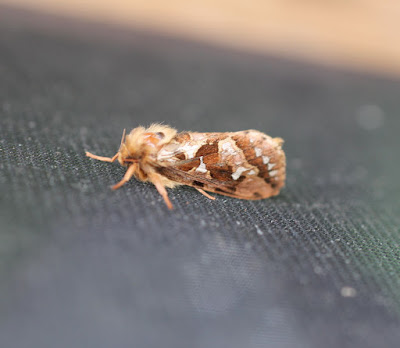 |
| Clouded Border (Lomaspilis marginata) |
This is possibly the prettiest moth I have seen in a long time and only the second to be seen at Shandy Hall. One of the UPenn students recorded it in the moth trap a few years ago, but it wasn't quite as fresh as this one which was newly minted. The Clouded Border (Lomaspilis marginata) is similar to the Magpie moth in that the markings on the wings are not consistent; the clouds and the border appear in a variety of shapes.
The scientific name derives from the Greek for a 'hem or fringe' (loma); spilos meaning a spot or a stain. Marginis gives us a margin along the edges of both wings. The moth rests with its wings spread, as in the photograph. It is common throughout the UK and the caterpillar feeds on aspen, poplars and willows.
 |
| Map-winged Swift (Hepialus fusconebulosa) |
Another moth that was recorded by the students (on one occasion only) but I had not seen before. When I saw it this morning I couldn't work it out and was beginning to think it was a malformed Golden Y. But then something in its slightly ponderous movements reminded me of the Ghost Moth (or Ghost Swift) and I then deduced it must be one from that family. When producing eggs following mating, the female Map-winged Swift broadcasts them over vegetation while in flight; no selection of the appropriate food-plant with precision like many other insects.
 |
| (Chrysoteuchia culmella) |
The Garden Grass Veneer is the common name for this species which can be found in abundance throughout the country. With its jackdaw blue eye and clearly ingrained patterns on its forewings it is easy to identify. The white line at the base of the wings glitters brightly and the scientific name can be translated as 'to make with gold'. The larvae feed at the base of grass stems and the moth is on the wing between May and September.
 |
| (Phycitodes binaevella) |
Phycitodes binaevella is the name given to this moth - again only seen once before in the garden. Out of focus in the background is a Lewington drawing of the species showing (rather murkily) the two (bi) moles (naevus) that can be seen on the forewings. It was difficult to get a good photograph but I think this one is clear enough to make it a correct identification.
Other moths from last night included : Buff Arches, Poplar Hawk-moths (6), Barred Straw (4), Udea ovalis (10), Beautiful Hook Tip (2), Burnished Brass and the first Large Yellow Underwing.
